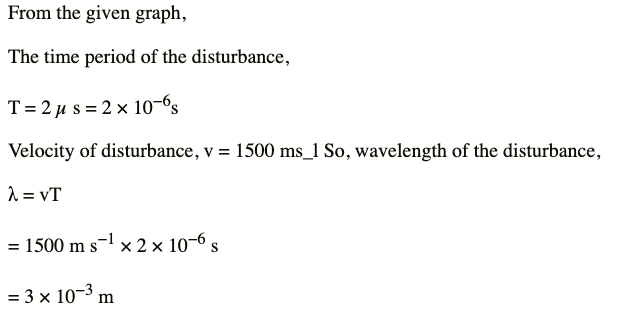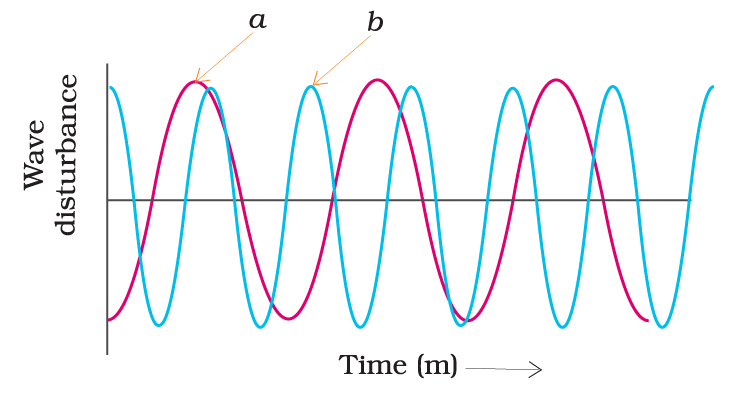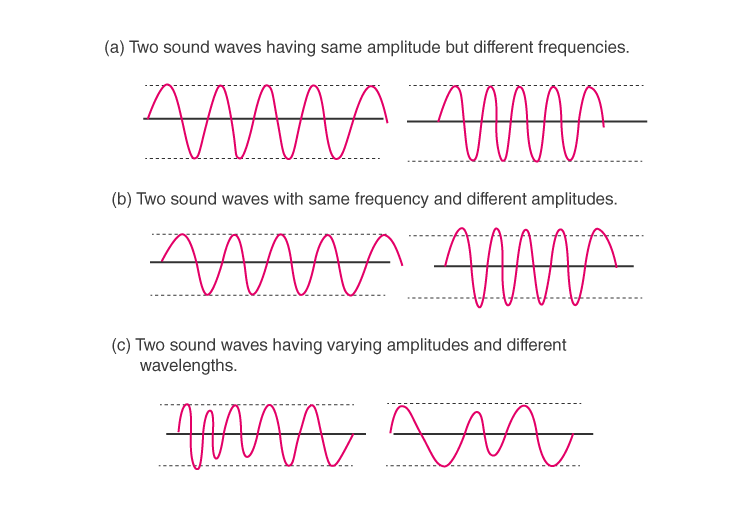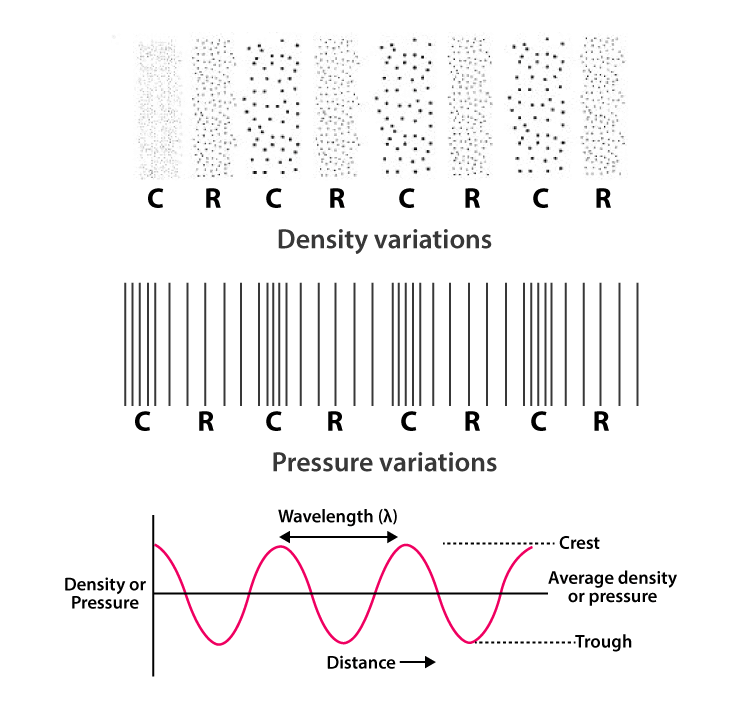NCERT Exemplar: Sound | Science Class 9 PDF Download
Multiple Choice Questions
Q.1. Note is a sound
(a) of mixture of several frequencies
(b) of mixture of two frequencies only
(c) of a single frequency
(d) always unpleasant to listen
Ans: (a)
Explanation: Sound is a mixture of several frequencies which can be produced by vibrating objects.
Q.2. A key of a mechanical piano struck gently and then struck again but much harder this time. In the second case
(a) Sound will be louder but pitch will not be different
(b) Sound will be louder and pitch will also be higher
(c) Sound will be louder but pitch will be lower
(d) Both loudness and pitch will remain unaffected
Ans: (a)
Explanation: Pitch depend on the frequency particular key and loudness depends on force by which key is pressed.
Q.3. In SONAR, we use
(a) Ultrasonic waves
(b) Infrasonic waves
(c) Radio waves
(d) Audible sound waves
Ans: (a)
Explanation: SONAR (Sound Navigation and Ranging) uses ultrasonic waves (high-frequency sound waves above 20,000 Hz) to detect objects underwater. These waves travel through water, reflect off surfaces, and return as echoes, helping in navigation, depth measurement, and detecting underwater objects like submarines and marine life.
Q.4. Sound travels in air if
(a) Particles of medium travel from one place to another
(b) There is no moisture in the atmosphere
(c) Disturbance moves
(d) Both particles as well as disturbance travel from one place to another.
Ans: (c)
Explanation: Sound waves propagate by vibrating in its own position. Whereas disturbance created by vibration of particles moves from one place to another.
Q.5. When we change feeble sound to loud sound we increase its
(a) Frequency
(b) Amplitude
(c) Velocity
(d) Wavelength
Ans: (b)
Explanation: Loudness of sound is proportional to amplitude. When amplitude increases feeble sound change to loud sound.
Q.6. In the curve (Fig.12.1) half the wavelength is (a) A B
(a) A B
(b) B D
(c) D E
(d) A E
Ans: (b)
Explanation: Wavelength is the distance between two consecutive troughs. In the graph half, the wavelength will BD.
Q.7. Earthquake produces which kind of sound before the main shock wave begins
(a) Ultrasound
(b) Infrasound
(c) Audible sound
(d) None of the above
Ans: (b)
Explanation: It is due to infrared rays few animals sense the earthquake, and they behave abnormally before the earthquake.
Q.8. Infrasound can be heard by
(a) Dog
(b) Bat
(c) Rhinoceros
(d) Human beings
Ans: (c)
Explanation: Infrasound have frequency less than 20 Hz and Rhinoceroses communicate using Infrasound waves of the frequency of 5 Hz hence rhinoceros is the right answer.
Q.9. Before playing the orchestra in a musical concert, a sitarist tries to adjust the tension and pluck the string suitably. By doing so, he is adjusting
(a) Intensity of sound only
(b) Amplitude of sound only
(c) Frequency of the sitar string with the frequency of other musical instruments
(d) Loudness of sound
Ans: (c)
Explanation: Artists adjust the frequencies before beginning to play instruments because musical instruments should be tuned in with other musical instruments to produce pleasant music.
Short Answer Questions
Q.10. The given graph (Fig.12.2) shows the displacement versus time relation for a disturbance travelling with a velocity of 1500ms–1. Calculate the wavelength of the disturbance.
Ans: 
Q.11. Which of the above two graphs (a) and (b) (Fig.12.3) representing the human voice is likely to be the male voice? Give the reason for your answer.
Ans: Pitch of a male voice is lighter than the pitch of female hence the graph a represent male voice.
Q.12. A girl is sitting in the middle of a park of dimension 12 m × 12 m. On the left side of it there is a building adjoining the park and on right side of the park, there is a road adjoining the park. A sound is produced on the road by a cracker. Is it possible for the girl to hear the echo of this sound? Explain your answer.
Ans: Echo can be heard if the gap between the original sound and reflected sound received by the listener is around 0.1 sec.
Sound Velocity × time interval
= 344 × 0.1
= 34.4 m
Here sound reflects from the building and then reaches the girl which is much smaller than the required distance. Hence echo cannot be heard.
Q.13. Why do we hear the sound produced by the humming bees while the sound of vibrations of a pendulum is not heard?
Ans: Humming bees produce the sound by beating their wings and the frequency of the sound they produce will be in the range of 20Hz to 20000 Hz which is audible. On the other hand, pendulum produces sound less than 20 Hz which is below audible range, and we don’t hear the sound of pendulum vibrations.
Q.14. If any explosion takes place at the bottom of a lake, what type of shock waves in water will take place?
Ans: The answer is longitudinal waves
Q.15. The sound produced by a thunderstorm is heard 10 s after the lightning is seen. Calculate the approximate distance of the thundercloud. (Given the speed of sound = 340 m s–1.)
Ans: Distance = speed × time
Here speed = 340 m/s.
Time = 10s
Distance = 340 × 10 = 3400m.
Q.16. For hearing the loudest ticking sound heard by the ear, find the angle x in the Fig.12.4.
Ans: Angle of incidence is always equal to the Angle of reflection
Angle of Incidence = 90° - 50° = 40°.
Angle of reflection= angle of incidence = 40°.
Hence angle x is 40°.
Q.17. Why is the ceiling and wall behind the stage of good conference halls or concert halls made curved?
Ans: Ceiling and wall behind the stage of good conference halls or concert halls made curved to ensure the reflected sound equally to all the audience.
Long Answer Questions
Q.18. Represent graphically by two separate diagrams in each case
(i) Two sound waves having the same amplitude but different frequencies?
(ii) Two sound waves having the same frequency but different amplitudes.
(iii) Two sound waves having different amplitudes and also different wavelengths.
Ans: 
Q.19. Establish the relationship between speed of sound, its wavelength and frequency. If velocity of sound in air is 340 m s–1, calculate
(i) wavelength when frequency is 256 Hz.
(ii) frequency when wavelength is 0.85 m
Ans: Relationship between Sound speed, wavelength and frequency
Speed = distance/time
V = wavelength/time
V = wavelength × 1/time
Frequency = 1/time
V = wavelength × frequency
1) Wavelength = speed/frequency
= 340/256
= 1.32 m
2) Frequency = speed / wavelength
= 340/0.85
= 400 HZ
Q.20. Draw a curve showing density or pressure variations with respect to distance for a disturbance produced by sound. Mark the position of compression and rarefaction on this curve. Also define wavelengths and time period using this curve.
Ans: A sound wave shown in a graphic form illustrates how density and pressure change as the sound wave travels through the medium. The density and pressure of the medium vary with distance, both above and below the average values.

- Compressions are areas where particles are closely packed. They are represented by the upper part of the curve, where density and pressure are high.
- Rarefactions are areas of low pressure where particles are spread apart, represented by the lower part of the curve. The peak is referred to as the crest, and the dip is called the trough of the wave.
|
84 videos|478 docs|60 tests
|
FAQs on NCERT Exemplar: Sound - Science Class 9
| 1. What is sound and how is it produced? |  |
| 2. What are the different types of sound waves? |  |
| 3. How do the properties of sound affect its propagation? |  |
| 4. What is the difference between pitch and loudness in sound? |  |
| 5. How does sound travel through different mediums? |  |
















